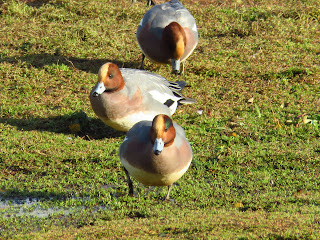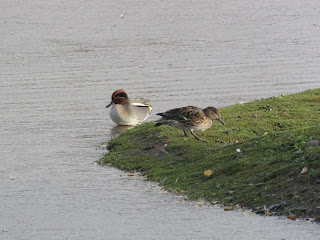On a bright, brisk and breezy morning I decided on a visit to the SOS Reserve at Venus Pool. All these photos taken from the public hide.
A pair of Greylag Geese have a talk (the bi-coloured bill on the left-hand bird is shadow). A pair of Eurasian Wigeon behind.
Three Eurasian Wigeon: the drake on the left is odd in that it shows a very prominent green patch behind the eye, recall a drake Teal. The drake on the right shows a hint of a small green patch. Most literature illustrates the eye with a dark surround but makes no mention that this can gloss green.
The right hand of this pair shows a hint of green behind the eye: the left-hand bird shows no such hint.
The ‘green-eyed’ bird is in the lead here. The bird behind shows a hint. I recall taking a photo of an eclipse drake at the lake earlier this Autumn that puzzled me by showing this feature. Strange.
Get the angle right and it really glows.
The green on a drake Teal is much larger than shown on ‘our’ Eurasian Wigeon and has a yellow surround. The duck Teal is very plain: we can just see the green speculum though the white side of the tail is often noticeable at long range.
A fine drake Teal indeed. To reprise my Priorslee Lake is it blue or green discussion if the patch on the head is green then the speculum just visible it clearly blue to my eyes. Not what the books tell us!
To carry on the ‘gloss’ discussion even adult Cormorants when viewed from the correct angle. We see it here on the ‘shoulder’ of the middle bird here (Lapwings in foreground).
After fishing time to hang the wings out.
A Carrion Crow in full-cry, literally!
A real surprise was this Chiffchaff that flew past the hide and stayed in view just long-enough for me to get a record shot. A very yellow-looking bird: after the Autumn moult they are generally yellow-toned but this seems rather extreme. Perhaps just the low sun?
A jaunty Wren.
A Blackbird at the haws. It is easy to see why some birds are misidentified as Song Thrushes. Separate this juvenile by the reddish-brown tone on the breast – yellowish on a Song Thrush. The lack of marks on the face. And the ‘spots’ are white smudges on a dark background whereas a Song Thrush always show dark spots on a pale background.
Goldfinches have pointed bills that enable them to extract seeds from teasel heads, as here.
Head-on Goldfinches show a surprisingly dark mask.
Here we see the marking on the wings and tail. Note that the rump of Goldfinches is white: we usually think that a white rump on a finch means ‘Bullfinch’: it often does as it is much more prominent on that species.
Why does it not hurt its feet standing on a teasel? (note the rain streaks).
Small finch with grey in the tail: “Linnet” I thought. But why is it so heavily streaked? Juvenile? And why does it have a pale bill? Ah – it is in fact a Lesser Redpoll.
Even the back is well-streaked. And upon reflection there is no white on the side of the tail.
Obligingly it turned around and we can see the red ‘poll’ – crown. We also see the ‘Hitler-moustache’ (am I allowed to say that in these PC days?) that eliminates any possibility of similar but unlikely Twite.
Hard to see the red ‘poll’ from some angles”




















